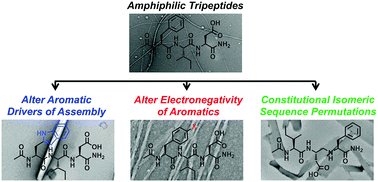Aromatic identity, electronic substitution, and sequence in amphiphilic tripeptide self-assembly†
Abstract
The phenomenon of self-assembly in short peptides (2–4 amino acids) has been a source of curiosity, in part for its role in helping to better understand and predict how minimal sequences within proteins might contribute to the formation of larger structures or aggregates. Building on previous work in this field, here we investigate a family of amphiphilic tripeptides for their self-assembly and hydrogel formation. From a parent peptide, Ac-FID-NH2, which was previously shown to self-assemble into high aspect-ratio filaments and form hydrogels, we explored the significance of structural features or sequence variations on the observed self-assembly. This process entailed substituting key aromatic residues, altering the electronics of these aromatic drivers of assembly, and screening tripeptide constitutional isomers. This work more clearly elucidates the mechanisms and design parameters that govern the creation of materials from short peptide building blocks, as well as offering greater insight into the interactions between minimal segments of proteins that underlie their structure and aggregation.



 Please wait while we load your content...
Please wait while we load your content...